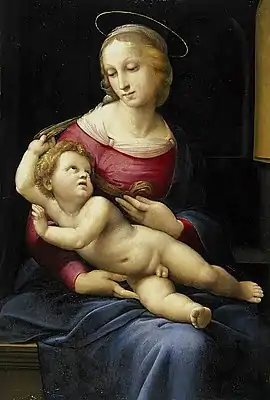| Bridgewater Madonna | |
|---|---|
 | |
| Artist | Raphael |
| Year | c. 1507 - 1508 |
| Type | oil on canvas |
| Dimensions | 81 cm × 55 cm (32 in × 22 in) |
| Location | Scottish National Gallery, Edinburgh |
The Bridgewater Madonna (in Italian, Madonna Bridgeland) is a religious painting by Raphael, dated 1507. Originally on oil and wood, but later transferred to canvas, it measures 81 by 55 cm. The picture is part of the permanent collection of the Scottish National Gallery in Edinburgh, on loan from the Duke of Sutherland Collection.[1]
History
The work by Raphael has been attributed to his mature period in Florence. In the seventeenth century it was acquired in France as part of the Seignelay collection, eventually becoming the property of the Duke of Orleans, at the Palais-Royal in Paris. In 1792 the painting was purchased for £3,000 by the Duke of Bridgewater (later Earl of Ellesmere). Until 1945 it remained at Bridgewater House, from which it takes its name. It is currently on loan to the Scottish National Gallery from the collection of the Duke of Sutherland (another branch of the same aristocratic family).[2][3]
Preparatory drawings for the work in the Albertina Museum in Vienna and the British Museum in London show that Raphael was partly inspired by the Florentine works of Michelangelo and Leonardo da Vinci, with painterly features typified by chiaroscuro effects and lively intertwined portrayals of the virgin and child.[4] The painting was probably intended to be displayed as a devotional image in a private chamber.[5]
Description and style
On a dark background, in which most features are barely discernible – a niche with an open door, a bench – the Virgin nurses her Child in her lap, while He gently moves around on the left. In an exceptionally harmonious and balanced group, the pair are characterised by their opposing and divergent gestures that generate a serpentine movement – the Child's arms holding the Madonna's veil, her hands touching the Child's body. In an effective way, the intense and vivid colours bring substance to the intertwined figures emerging from the shadows.[2][6][1]
Raphael made many drawings and paintings of the Virgin and Child in Florence. The artful combination of gestures are particularly graceful, with an elegant contraposto twist. The gaze between the exquisite Mother and Child underlines its tenderness. Technical X-ray analysis shows that originally the artist painted a landscape as background, typical of earlier portrayals of the Madonna. Probably Raphael later decided that choosing a dark background allowed the pair to be painted more subtly, increasing the contrast between light and shade, and thus enhancing the sense of volume and monumentality.[5]
Raphael's motifs were foreshadowed by two earlier Florentine artists of the High Renaissance, Michelangelo and Leonardo da Vinci. In Michelangelo's sculpted Taddei Tondo, the Madonna is portrayed with the Christ Child outstretched on her knees, accompanied by the infant St John clutching a fluttering bird; and the motif of a serenely smiling Virgin and Child, depicted in contraposto on a dark background, is derived from da Vinci. Other copies of Raphael's painting exist: a version in the National Gallery, London; and an oval version, now held by the National Trust in Nostell Priory, Yorkshire.[7][8]
See also
Notes
References
- De Vecchi, Pierluigi; Cerchiari, Elda (1999). I tempi dell'arte (in Italian). Vol. 2. Milan: Bompiani. ISBN 88-451-7212-0. .
- Pierluigi, De Vecchi (1975). Raffaello. Milan: Rizzoli.
- Franzese, Paolo (2008). Raffaello. Milan: Mondadori Arte. ISBN 978-88-370-6437-2.
- Murray, Linda (1977). "The New Century". The High Renaissance and Mannerism: Italy, the North, and Spain 1500–1600. The World of Art. New York and Toronto: Oxford University Press. pp. 7–33. ISBN 0195199901.
- Champlin, John Edison Jr. (1886). "Bridgewater, Madonna". Cyclopedia of painters and painting (PDF). Vol. 3. Laar-Quost. pp. 129–130.
External links
 Media related to Bridgewater Madonna at Wikimedia Commons
Media related to Bridgewater Madonna at Wikimedia Commons- National Galleries Scotland (2020). "Online catalogue of the National Galleries of Scotland". Nationalgalleries.org. Retrieved 6 January 2022.
- Prince Albert (1832). "The Virgin and Child ['The Bridgewater Madonna'], Engraving by Constant Louis Antione Lorichon". Royal Collection Trust. Retrieved 6 January 2022.
- St Oswald Collection (2010). "Madonna and Child, the Bridgewater Madonna, after Raphael". The National Trust. Nostell Priory, West Yorkshire. Retrieved 6 January 2022.